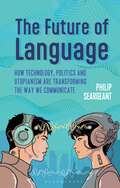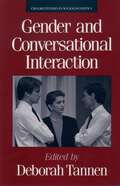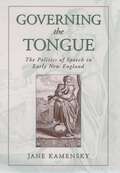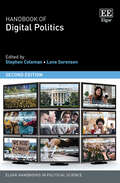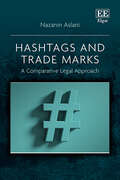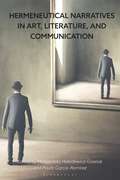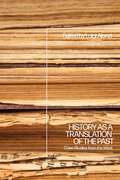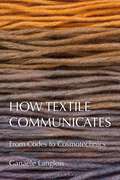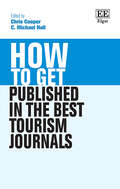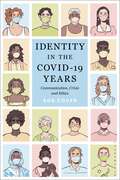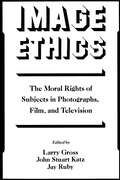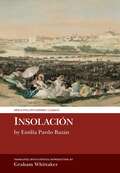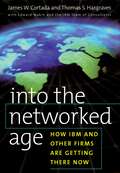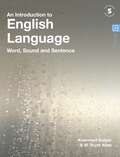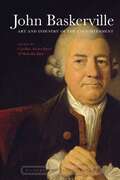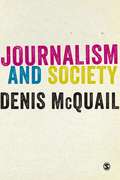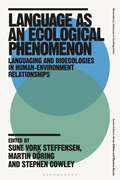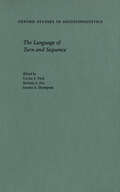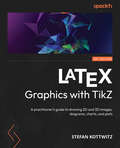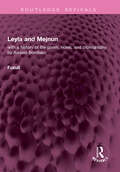- Table View
- List View
The Future of Language: How Technology, Politics and Utopianism are Transforming the Way we Communicate
by Dr Philip SeargeantWill language as we know it cease to exist? What could this mean for the way we live our lives?Shining a light on the technology currently being developed to revolutionise communication, The Future of Language distinguishes myth from reality and superstition from scientifically-based prediction as it plots out the importance of language and raises questions about its future. From the rise of artificial intelligence and speaking robots, to brain implants andcomputer-facilitated telepathy, language and communications expert Philip Seargeant surveys the development of new digital 'languages', such as emojis, animated gifs and memes, and investigates how conventions of spoken and written language are being modified by new trends in communication. From George Orwell's fictional predictions in Nineteen Eighty-Four to the very real warnings of climate activist Greta Thunberg, Seargeant explores language through time, traversing politics, religion, philosophy, literature, and of course technology, in the process. Tracing how previous eras have imagined the future of language, from the Bible to the works H. G. Wells, and from Star Wars to Star Trek, the book reveals how perfecting language and communication has always been a vital component of utopian dreams of the future. Questioning the potential ramifications of recent and future developments in communication on society and its ideals, The Future of Language is a no holds barred investigation into the state of civilisation and the impact that changes in language could have on our lives.
Governing The Tongue: The Politics Of Speech In Early New England
by Jane KamenskyGoverning the Tongueexplains why the spoken word assumed such importance in the culture of early New England. In a work that is at once historical, socio-cultural, and linguistic, Jane Kamensky explores the little-known words of unsung individuals, and reconsiders such famous Puritan events as the banishment of Anne Hutchinson and the Salem witch trials, to expose the ever-present fear of what the Puritans called "sins of the tongue." But even while dangerous or deviant speech was restricted, as Kamensky illustrates here, godly speech was continuously praised and promoted. Congregations were told that one should lift one's voice "like a trumpet" to God and "cry out and cease not." By placing speech at the heart of New England's early history, Kamensky develops new ideas about the complex relationship between speech and power in both Puritan New England and, by extension, our world today.
Handbook of Digital Politics: Second Edition (Elgar Handbooks in Political Science)
This thoroughly revised second edition Handbook examines the latest knowledge and perspectives on digital politics. Through new content on digital populism, filter bubbles, algorithmic power, AI, non-Western digital politics, election communication regulation and right-wing alternative news media, contributors challenge the binary of cyber-optimism and cyber-pessimism and argue for a more nuanced understanding of political change.Arranged around key themes, this Handbook investigates the meaning of digital politics and analyses the impact of new technologies and platforms on politics. Chapters consider the digital reconfiguration of civic practices, political institutions and journalism. Leading scholars provide original, incisive and provocative insights into cutting-edge issues, exploring how the expansion of digital technologies, channels and styles shapes political dynamics.Providing a broad and in-depth overview of digital politics, this Handbook will be an invaluable resource for researchers, educators and students of politics, media and communication studies, journalism, technology and governance. It will also be essential reading for political practitioners, policy-makers and strategists seeking to better understand the digital world.
Hashtags and Trade Marks: A Comparative Legal Approach
by Nazanin AslaniThis timely book examines the growing importance of hashtags both in online culture and within our digital society. Conducting a comparative analysis of legal strategies within the EU, Germany, and the United States, it aims to ascertain whether a fair balance currently exists between freedom of expression and competition in the treatment of hashtags as trade marks. Nazanin Aslani firstly introduces a novel taxonomy of hashtags, highlighting their multifaceted functions, which goes beyond their commercial value to encompass their expressive, communicative, and organisational aspects. The book then highlights the need for a deeper understanding of hashtag functions, arguing that this lack of understanding has led to mischaracterisation by courts and registries, which in turn has led to contradictory case outcomes. Featuring an extensive analysis, this book advocates for strong fair use defences to maintain a balance between protection and free expression, competition, and internet regulation and deregulation. Providing a unique focus on this evolving subject, Hashtags and Trade Marks will be an excellent resource for academics of comparative trade mark, unfair competition and intellectual property law. Practitioners, policy makers and in-house counsel will also benefit from this book to fill in knowledge gaps surrounding hashtags and provide solutions for organisational devices used as trade marks yet to be developed.
Hermeneutical Narratives in Art, Literature, and Communication
Exploring the relationship between hermeneutics and the arts, including painting, music, and literature, this book builds on hermeneutics from a practical perspective, connecting this area of critical research with others to reveal how it is viewed from different perspectives. International and interdisciplinary in scope, this edited volume draws on the work of scholars and practitioners working across a variety of subject areas, themes and topics, including philosophy, literature, religious paintings, musical oeuvres, Chinese urbanscapes, Moroccan proverbs, and Ukrainian internet blogs. Focusing on the idea of hermeneutics as a discipline that can connect different areas of interest, the book offers an inside view into how the contributors 'interpret' it within their own academic remits, demonstrating its presence in qualitative academic interpretations and canonical contemporary research in humanities.
History as a Translation of the Past: Case Studies from the West
This volume considers how the act through which historians interpret the past can be understood as one of epistemological and cognitive translation. The book convincingly argues that words, images, and historical and archaeological remains can all be considered as objects deserving the same treatment on the part of historians, whose task consists exactly in translating their past meanings into present language. It goes on to examine the notion that this act of translation is also an act of synchronization which connects past, present, and future, disrupting and resetting time, as well as creating complex temporalities differing from any linear chronology. Using a broad, deep interpretation of translation, History as a Translation of the Past brings together an international cast of scholars working on different periods to show how their respective approaches can help us to better understand and translate the past in the future.
How Textile Communicates: From Codes to Cosmotechnics
by Dr. Ganaele LangloisTextile has been used as a medium of communication since the prehistoric period. Up until the 19th century, civilizations throughout the world manipulated thread and fabric to communicate in a way that would astound many of us now. Unlike text and images, textile is haptic and three-dimensional. Its meaning is unfixed, constantly shifting as it circulates between different owners and creators. In How Textile Communicates, Ganaele Langlois dissects textile's unique capacity for communication through a range of global case studies, before examining the profound impact of colonialism on textile practice and the appropriation of this medium by capitalist systems. A thought-provoking contribution to the fields of both fashion and communication studies, Langlois' writing challenges readers' preconceptions and shines new light on the profound impact of textiles on human communication.
How to Get Published in the Best Tourism Journals (How To Guides)
Drawing on a wealth of knowledge and experience from leading tourism academics and journal editors, this practical How To guide offers clear-sighted advice on how to craft a high-quality paper in terms of contribution, positioning and submission. Accessible and comprehensive, it demystifies the process of getting published in the top tourism journals.This insightful book begins by mapping out the tourism publishing landscape, before delving into the various methods of building a refereed journal paper and navigating tourism publishers. Chapters dissect contemporary publishing issues, including gender inequality, ethics and integrity, and the dominance of English language publishing. Finally, contributors outline the essential role of publishing in shaping an academic career in tourism, especially in securing jobs, obtaining grant funding and creating pathways for career progression.How to Get Published in the Best Tourism Journals offers an insider perspective and practical advice while posing questions about the future of tourism publishing in the light of developments such as AI and Open Access. It will prove an essential resource to enhance journal publication success for tourism PhD students, as well as tourism academics at all career stages.
Identity in the COVID-19 Years: Communication, Crisis, and Ethics
by Rob CoverIdentity in the Covid-19 Years explores the how the COVID-19 pandemic has been represented in media, communication and culture, and the role these changes have played in renewing how we understand identity, engage in social belonging and relate ethically to each other and the world. This book explores how the COVID-19 pandemic has had a significant impact on how we perform our identities, engage in social belonging, and communicate with each other. Understanding the onset of the pandemic as a moment experienced as cultural rupture, Cover provides a framework for understanding how selfhood, belonging, relationships and perceptions of time and space have undergone a disruption that not only is damaging to continuity and stability but also provides positive value through renewal and the re-making of the self and ways of living ethically. Drawing on philosophic, media and cultural studies approaches, this book describes how networks of mutual care and global interdependency have been powerfully drawn out by the experience of the pandemic, yet also disavowed in some settings in favour of a problem individualism and sustained inequalities. The roles of disruption and interdependency are examined across an array of pandemic-related topics, including health communication, apocalyptic storytelling, lockdowns and immobilities, mask-wearing, social distancing and new practices touch, anti-vaccination discourses, and frameworks for mourning the lost past and the uncertain future. By focusing on the impact of the pandemic on identity, this work explains and revisits theories of belonging and ethics to help us understand how new ways of perceiving our vulnerability may lead to more positive, inclusive and ethical ways of living.
Image Ethics: The Moral Rights Of Subjects In Photographs, Film, And Television
by Larry Gross John Stuart Katz Jay RubyIn the Footsteps of Flora Tristan: A Political Biography (Studies in Labour History #14)
by Máire Fedelma CrossIn the Footsteps of Flora Tristan is the first ever study devoted to Jules Puech (1879–1957), and is a double biography that examines his life’s work on Flora Tristan (1803–1844), feminist and socialist. It begins by examining newly found press reports of Flora Tristan during her lifetime and subsequently, then positions Puech’s discovery of her, as a postgraduate student in Paris in the 1900s. It continues with an account of how he embarked on the first in-depth biography published in 1925. Puech was unmatched in his expertise as a writer on Flora Tristan having discovered her papers through his numerous political connections and having become a historian of Proudhon’s legacy on the international aspirations of the labour movement. Together with his wife Marie-Louise Puech, née Milhau (1876-1966), suffragist feminist, he was a militant in the early twentieth-century pacifist movement that advocated international arbitration. His research on Flora Tristan was enriched by his other projects but was thwarted by the wars of 1914–1918 and 1940–1945. The circumstances of the long gestation of Puech's biography are drawn from his letters and papers, hitherto unseen. The correspondence curated brings a new understanding to the multi-faceted nature of Puech’s activism and rate of progress in the publication of his findings on his subject, Flora Tristan.
Insolación: by Emilia Pardo Bazán (Aris & Phillips Hispanic Classics)
by Graham WhittakerEmilia Pardo Bazán, the most prolific and influential Spanish female writer of the nineteenth century, was a very controversial figure, vilified for her embracement of naturalism and her robust feminist stance.When Insolación was published in 1889 it provoked a litany of negative comments and personal insults. This subtle, psychological novel, drawing on many aspects of its author's personal life, deals with the relationship between Asís, a respectable Galician widow, and Pacheco, a feckless womaniser from Andalucía. Although they scarcely know each other, Asís accepts Pacheco's invitation to visit the San Isidro Fair, where a heady cocktail of sun, alcohol and revelry causes her to behave in an uncharacteristic manner.Insolación explores the conflict between Asís's self-recrimination and concern for the 'qué dirán' and her nascent sexuality. Finally, despite her determination to banish Pacheco from her mind and her intention to go back to Galicia, the couple sleep together and decide to marry.The perceived promiscuity of this work of fiction scandalised the reading public as well as many leading critics. Pereda considered Asís's behaviour reprehensible and Clarín dismissed the novel as a pseudo-erotic boutade. Nowadays, Insolación is recognised as an important novel.
Into The Networked Age: How Ibm And Other Firms Are Getting There Now
by James W. Cortada Thomas S. Hargraves Edward WakinAn Introduction to English Language: Word, Sound and Sentence
by Koenraad Kuiper W. Scott AllanRefreshed and updated, the fifth edition of this core textbook offers a clear and engaging introduction to the building blocks of the English language, namely its words, sounds and sentences. Assuming no prior knowledge, it combines accessibility with depth, offering detailed explanations of key topics and theories, including variation in vocabularies, the International Phonetic Alphabet and relevance theory in relation to pragmatics. Packed full of exercises to help consolidate learning, and equipped with examples and illustrations throughout, An Introduction to English Language is essential reading for undergraduate students of English language and linguistics and a valuable resource for students and teachers of English as a second or foreign language. This new edition features: - An enhanced text design - Updated examples - Refreshed illustrations - New and improved exercises - Revised further reading lists. The book is divided into three parts, with succinct overviews and clearly-defined learning outcomes at the start of each section, followed by glossaries of technical terms at the end. It is also accompanied by a wealth of online resources, including downloadable PowerPoints, MP3 audio files, MP4 video lectures, and quizzes, further supporting readers in achieving their goals.
John Baskerville: Art and Industry in the Enlightenment (Eighteenth-Century Worlds #7)
by Caroline Archer-Parré Malcolm DickThis book is concerned with the eighteenth-century typographer, printer, industrialist and Enlightenment figure, John Baskerville (1707-75). Baskerville was a Birmingham inventor, entrepreneur and artist with a worldwide reputation who made eighteenth-century Birmingham a city without typographic equal, by changing the course of type design. Baskerville not only designed one of the world’s most historically important typefaces, he also experimented with casting and setting type, improved the construction of the printing-press, developed a new kind of paper and refined the quality of printing inks. His typographic experiments put him ahead of his time, had an international impact and did much to enhance the printing and publishing industries of his day. Yet despite his importance, fame and influence many aspects of Baskerville’s work and life remain unexplored and his contribution to the arts, industry, culture and society of the Enlightenment are largely unrecognized. Moreover, recent scholarly research in archaeology, art and design, history, literary studies and typography, is leading to a fundamental reassessment of many aspects of Baskerville’s life and impact, including his birthplace, his work as an industrialist, the networks which sustained him and the reception of his printing in Britain and overseas. The last major, but inadequate publication of Baskerville dates from 1975. Now, forty years on, the time is ripe for a new book. This interdisciplinary approach provides an original contribution to printing history, eighteenth-century studies and the dissemination of ideas.
Journalism and Society
by Denis Mcquail"Every serious student of journalism should read this book... Denis McQuail has succeeded in producing a work of scholarship that shows what journalists do and what they should do." - Stephen Coleman, University of Leeds "For a half century we have spoken earnestly of journalism's responsibility to society instead of to business and government. Now this concept is given sophistication unmatched, by the best scholar of media theory of his generation." - Clifford Christians, University of Illinois "The grand old man of communication theory presents an overarching social theory of journalism that goes beyond the usual Anglo-American focus." - Jo Bardoel, University of Amsterdam (ASCoR) and Nijmegen "This book deals with the eternal question of how journalism is linked to society... I cannot think of a better staple food for students of journalism at all levels." - Kaarle Nordenstreng, University of Tampere This is a major new statement on the role of journalism in democracy from one of media and communication's leading thinkers. Denis McQuail leads the reader through a systematic exploration of how and why journalism and society have become so inextricably entwined and - as importantly - what this relationship should be like. It is a strong re-statement of the fundamental values that journalism aspires to. Written for students, this book: Makes the theory accessible and relevant Teaches the importance of journalism to power and politics Explores the status and future of journalism as a profession Outlines the impact and consequences of the digital Reveals journalism as it is, but also as it should be Takes each chapter further with guided reading list and free online journal articles. This textbook is the perfect answer to the how and why of journalism. It is crucial reading for any student of media studies, communication studies and journalism.
Language as an Ecological Phenomenon: Languaging and Bioecologies in Human-Environment Relationships (Bloomsbury Advances in Ecolinguistics)
Moving beyond a more traditional view of language as a discrete sociocultural and cognitive entity that distorts our understanding of surrounding ecologies, this book argues that the starting point for ecolinguistics is an appreciation of language as not just about nature, but of nature. Exploring this conceptual change in the field, the book presents a process view in which language is substituted by languaging, emphasising the bioecologies that we cohabit with numerous other species. It puts forward this perspective by looking at the theoretical considerations behind the understanding of languaging as bioecological, and through examining languaging in various contexts and places. Drawing on examples from across the world, it addresses topics such as climate catastrophes, corporate narratives, questions of ecological leadership, the bioecological implications of the COVID pandemic, and relational landscapes. It also makes use of data from across multiple bioecological settings, including the dairy and agricultural industries.
LaTeX Graphics with TikZ: A Practitioners Guide To Draw 2d And 3d Images, Diagrams, Charts, And Plots
by Stefan KottwitzA practitioner's guide to drawing 2D and 3D images, diagrams, charts, and plots
Latex Graphics With Tikz: A Practitioners Guide To Draw 2d And 3d Images, Diagrams, Charts, And Plots
by Stefan KottwitzLeyla and Mejnun: with a history of the poem, notes, and bibliography by Alessio Bombaci (Routledge Revivals)
by FuzuliFirst published in 1970, Leyla and Mejnun provides a thorough introduction to the Leyla and Mejnun love story and the various forms in which the story has appeared in the Islamic world. Finally, it offers for the delight of the English poetry lover, an extremely readable translation of the Turkish version of the story. This book will be of interest to students of literature and history.
Leyla and Mejnun: with a history of the poem, notes, and bibliography by Alessio Bombaci (Routledge Revivals)
by FuzuliFirst published in 1970, Leyla and Mejnun provides a thorough introduction to the Leyla and Mejnun love story and the various forms in which the story has appeared in the Islamic world. Finally, it offers for the delight of the English poetry lover, an extremely readable translation of the Turkish version of the story. This book will be of interest to students of literature and history.
